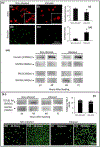Control of cellular adhesion and myofibroblastic character with sub-micrometer magnetoelastic vibrations
- PMID: 29477260
- PMCID: PMC8559148
- DOI: 10.1016/j.jbiomech.2018.02.007
Control of cellular adhesion and myofibroblastic character with sub-micrometer magnetoelastic vibrations
Abstract
The effect of sub-cellular mechanical loads on the behavior of fibroblasts was investigated using magnetoelastic (ME) materials, a type of material that produces mechanical vibrations when exposed to an external magnetic AC field. The integration of this functionality into implant surfaces could mitigate excessive fibrotic responses to many biomedical devices. By changing the profiles of the AC magnetic field, the amplitude, duration, and period of the applied vibrations was altered to understand the effect of each parameter on cell behavior. Results indicate fibroblast adhesion depends on the magnitude and total number of applied vibrations, and reductions in proliferative activity, cell spreading, and the expression of myofibroblastic markers occur in response to the vibrations induced by the ME materials. These findings suggest that the subcellular amplitude mechanical loads produced by ME materials could potentially remotely modulate myofibroblastic activity and limit undesirable fibrotic development.
Keywords: Magnetoelastic; Mechanotransduction; Vibrations.
Copyright © 2018 Elsevier Ltd. All rights reserved.
Conflict of interest statement
Conflict of Interest
The authors have no other conflicts of interest to declare.
Figures






Similar articles
-
Application of sub-micrometer vibrations to mitigate bacterial adhesion.J Funct Biomater. 2014 Mar 11;5(1):15-26. doi: 10.3390/jfb5010015. J Funct Biomater. 2014. PMID: 24956354 Free PMC article.
-
Real-time, in vivo investigation of mechanical stimulus on cells with remotely activated, vibrational magnetoelastic layers.Annu Int Conf IEEE Eng Med Biol Soc. 2011;2011:3979-82. doi: 10.1109/IEMBS.2011.6090988. Annu Int Conf IEEE Eng Med Biol Soc. 2011. PMID: 22255211
-
Magnetoelastic materials as novel bioactive coatings for the control of cell adhesion.IEEE Trans Biomed Eng. 2011 Mar;58(3):698-704. doi: 10.1109/TBME.2010.2093131. Epub 2010 Nov 18. IEEE Trans Biomed Eng. 2011. PMID: 21095859
-
Applicability of Low-intensity Vibrations as a Regulatory Factor on Stem and Progenitor Cell Populations.Curr Stem Cell Res Ther. 2020;15(5):391-399. doi: 10.2174/1574888X14666191212155647. Curr Stem Cell Res Ther. 2020. PMID: 31830894 Review.
-
From mechanotransduction to extracellular matrix gene expression in fibroblasts.Biochim Biophys Acta. 2009 May;1793(5):911-20. doi: 10.1016/j.bbamcr.2009.01.012. Epub 2009 Jan 31. Biochim Biophys Acta. 2009. PMID: 19339214 Review.
Cited by
-
Magnetostrictive alloys: Promising materials for biomedical applications.Bioact Mater. 2021 Jun 30;8:177-195. doi: 10.1016/j.bioactmat.2021.06.025. eCollection 2022 Feb. Bioact Mater. 2021. PMID: 34541395 Free PMC article. Review.
References
-
- Cai QY, Cammers-Goodwin A, Grimes CA, 2000. A wireless, remote query magnetoelastic CO2 sensorElectronic Supplementary information available. See http://www.rsc.org/suppdata/EM/b0/b004929h. J. Environ. Monit 2, 556–560. - PubMed
-
- Cai QY, Grimes CA, 2000. A remote query magnetoelastic pH sensor. Sens. Actuators B Chem 71, 112–117. - PubMed
-
- Cai QY, Jain MK, Grimes CA, 2001. A wireless, remote query ammonia sensor. Sens. Actuators B Chem 77, 614–619. - PubMed
-
- Chen K-D, Li Y-S, Kim M, Li S, Yuan S, Chien S, Shyy JY, 1999. Mechanotransduction in response to shear stress roles of receptor tyrosine kinases, integrins, and Shc. J. Biol. Chem 274, 18393–18400. - PubMed
Publication types
MeSH terms
Grants and funding
LinkOut - more resources
Full Text Sources
Other Literature Sources

